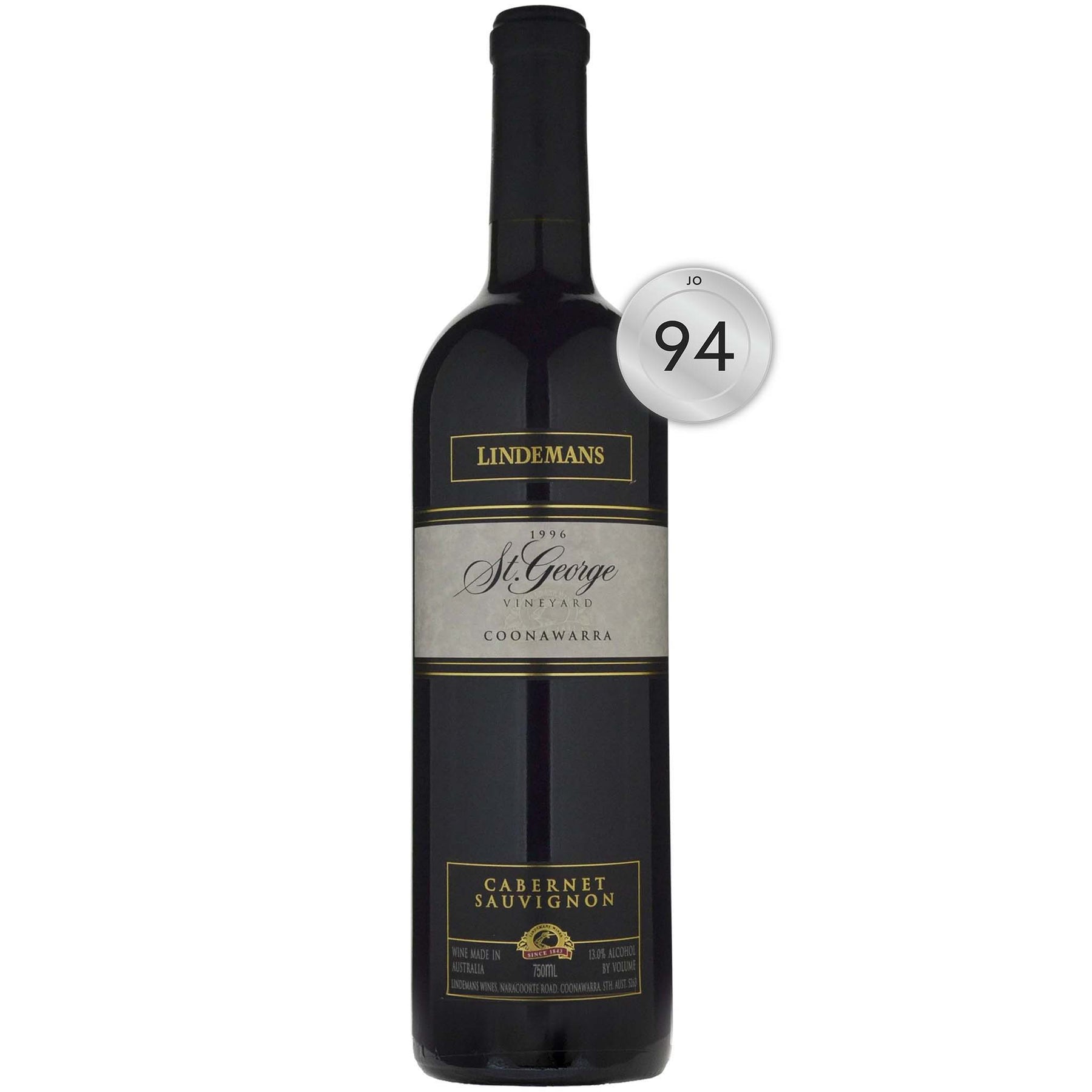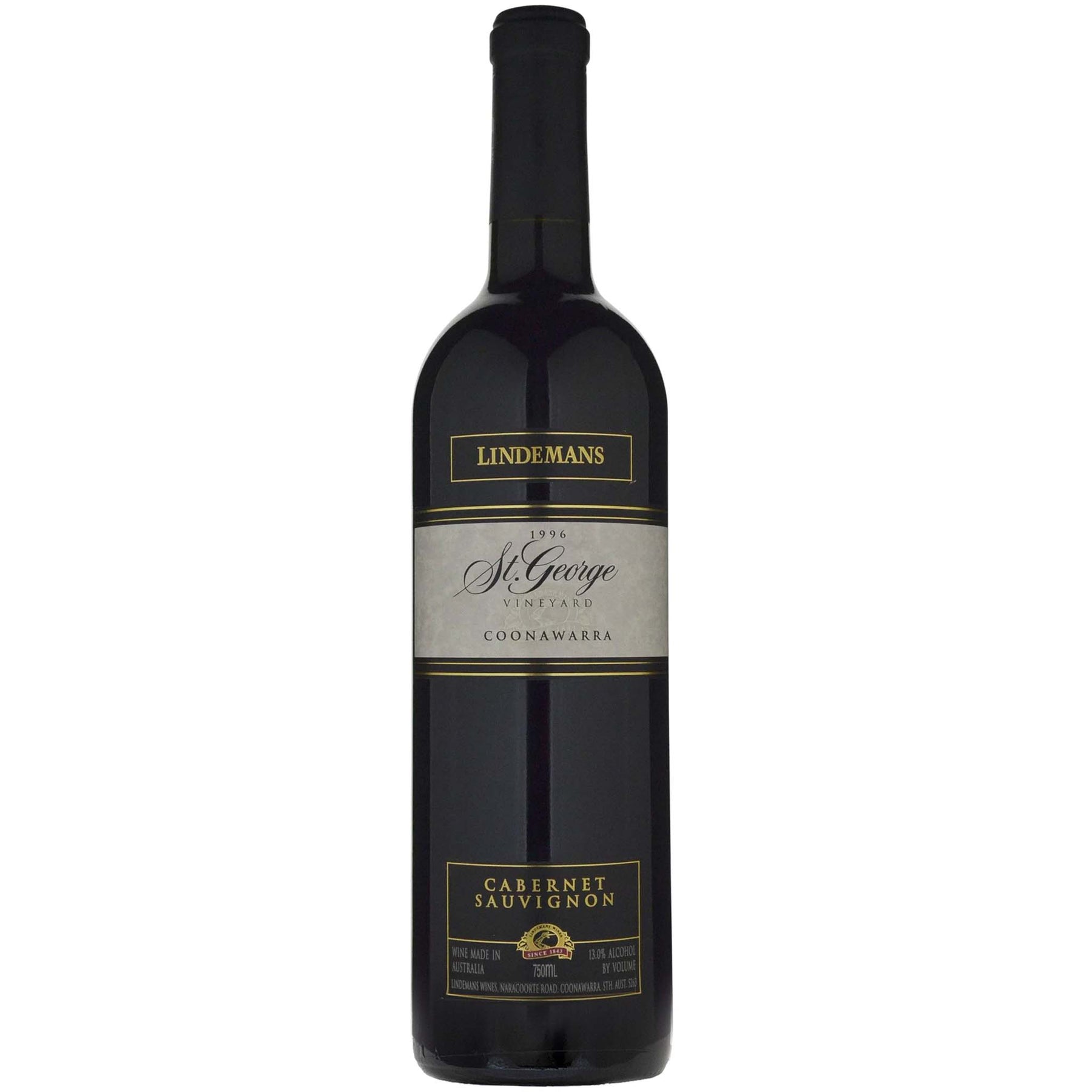

Lindemans St George Cabernet Sauvignon 1996
Style: Red Wine
Variety: Cabernet Sauvignon
Closure: Cork
Lindemans St George Cabernet Sauvignon 1996
Warehouse
34 Redland Drive
Vermont VIC 3133
Australia
Critic Score: 94
Alcohol: 13.0%
Size: 750 ml
Drink by: Now
"The Coonawarra Trio of Limestone Ridge Vineyard Shiraz Cabernet, St George Vineyard Cabernet Sauvignon and Pyrus Cabernet Sauvignon Merlot Malbec are all of exemplary quality." James Halliday
The Lindemans St George Cabernet Sauvignon is one of the three wines that make up Lindemans' famous Trio, which are the ultimate expression of Coonawarra and represent the pinnacle of the company's viticultural and winemaking skills. Fruit is sourced exclusively from the St George vineyard, which is located directly on the Limestone spine of the Terra Rossa, and was planted in 1969 with 12 hectares of cabernet sauvignon. The first release of St George Cabernet Sauvignon was the 1973 vintage.
"The sort of wine which simply wins hundreds of gold medals at Australian wine shows, since it's packed with explosive cassis and lightly herby cabernet fruit, packaged into very assertive and doubtless expensive smoky mocha oak and knit around fine, tight tannins." Jeremy Oliver
2006 Vintage Rating: "Another great vintage in Coonawarra. Very elegant, tight wines. Many bordeaux look-alikes." Andrew Wood, Divine Magazine
"Cabernet was without a doubt, the best performer in the Coonawarra for 1996," The wine was matured in new French oak hogsheads and barriques for 15 months. Dark purple-red colour. On the nose there are pronounced cedar and green-leaf Coonawana Cabernet fruit characters. The palate has full-bodied concentrated varietal Cabernet flavours with very good structure, length and soft tannins from extended skin contact, which nicely compliment the spicy fruit. Will gain further complexity with 5-8 years cellaring." Lindemans
Expert reviews
"The sort of wine which simply wins hundreds of gold medals at Australian wine shows, since it's packed with explosive cassis and lightly herby cabernet fruit, packaged into very assertive and doubtless expensive smoky mocha oak and knit around fine, tight tannins. Great now, but perhaps better used as a blending component in a more serious long-term wine since it just lacks complexity and the foundations to build it." Jeremy Oliver - 94 points
St George vineyard

Lindemans has a long history in the Coonawarra region through buying wines for blending in the 1950s before formally arriving in Coonawarra with the purchase of the Rouge Homme winery and its vineyards and land in 1965.
In addition to the 19 hectares of vineyards they acquired from Rouge Homme, they also acquired 119 hectares of red soil suitable for vines. Between 1967 and 1968, Limestone Ridge was the first vineyard planted by Lindemans after the acquisition. This was followed in 1969 by the St George vineyard, also located directly on the Limestone spine of the Terra Rossa strip, which was planted to 12 hectares of cabernet sauvignon. All of the vines on the block were clonally selected from the oldest and best clones of cabernet in the Coonawarra district, resulting in high and dependable yields.
The vineyard takes its name from Surgeon Major-General Hinton St George, who purchased the land in the early 1890s.
About the winery

Lindemans Hunter Valley Winery and Vineyards
Lindemans was founded in 1843 by Dr Henry John Lindeman who planted its first vines on his 816-acre property 'Cawarra' on the Upper Paterson River in the Hunter Valley wine region. The business flourished and nine years later, Lindeman established a head office, and storage and bottling facilities in Sydney.
Fast forward over a century and Lindeman's winemaker Karl Stockhausen crafted many sublime Hunter semillons (labelled Hunter River Riesling) in the mid-1950s to late-1960s, together with some great Hunter shiraz (labelled Hunter River Burgundy). The 1965 Lindemans Hunter River Burgundy Bin 3100 and 1965 Lindemans Hunter River Burgundy 3110 were iconic wines that generated a cult following in subsequent decades.
While Lindemans was established in the Hunter Valley, it was an early pioneer of cross-regional sourcing. Under the direction of Ray Kidd, one of Australia's great and largely unsung wine men, who ran Lindemans from 1962 to 1986, Lindemans expanded into the Barossa Valley, Coonawarra, Padthaway, Clare Valley and Corowa. Ray bought Leo Buring in 1962 and Rouge Homme in 1965, purchased the century-old Nursery vineyard (the oldest planting in Coonawarra) in 1965 and planted the Limestone Ridge and St Georges vineyards in 1967 and 1969 respectively. Lindemans produce their famous Trio of benchmark Coonawarra wines - St George Vineyard Cabernet Sauvignon, Limestone Ridge Vineyard Shiraz Cabernet and Pyrus Cabernet blend - from these three vineyards.
Lindemans most successful wine was the infamous Ben Ean Moselle which was aimed at the lower end of the market and produced in enormous quantities to compete with Orlando's Barossa Pearl. It financed much of Lindemans' growth in the 1970s and reached its peak in 1979 when it accounted for more than 20% of Australia's bottled white wine sales. Ben Ean was the creation of Ray Kidd while he was Lindemans' cellar and vineyard manager in the late 1950s and was originally produced from Hunter Semillon with some Verdelho. Kidd correctly predicted that the hugely successful fruity carbonated sweet Pearl wines would lead drinkers to demand still table wines with the same features.
In 2005, the Lindemans brand and assets, which had been previously owned by Foster's and Southcorp, were acquired by Treasury Wine Estates. The Coonawarra Trio continue to be a compelling expression of wine borne of the famed terra rossa soil, but sadly various factors including time, fashion and complacency have worked against their reputation. The globalisation of the brand name has also not helped, as they seem to get lost in such a commercially focused portfolio.

South Australia
South Australian is responsible for more than half the production of all Australian wine. It is home to more than 900 wineries across 18 wine regions. The regions are Adelaide Hills, Adelaide Plains, Barossa Valley, Clare Valley, Coonawarra, Currency Creek, Eden Valley, Kangaroo Island, Langhorne Creek, McLaren Vale, Mount Benson, Mount Gambier, Padthaway, Riverland, Robe, Southern Fleurieu, Southern Flinders Ranges and Wrattonbully.
Many of the well-known names in the South Australian wine industry established their first vineyards in the late 1830s and early 1840s. The first vines in McLaren Vale were planted at Reynella in 1839 and Penfold's established Magill Estate on the outskirts of Adelaide in 1844.
South Australia has a vast diversity in geography and climate which allows the State to be able to produce a range of grape varieties - from cool climate Riesling in the Clare and Eden Vallies to the big, full bodied Shiraz wines of the Barossa Valley and McLaren Vale. Two of Australia's best-known wines, Penfolds Grange and Henschke Hill of Grace, are produced here. There is much to discover in South Australia for the wine lover.

